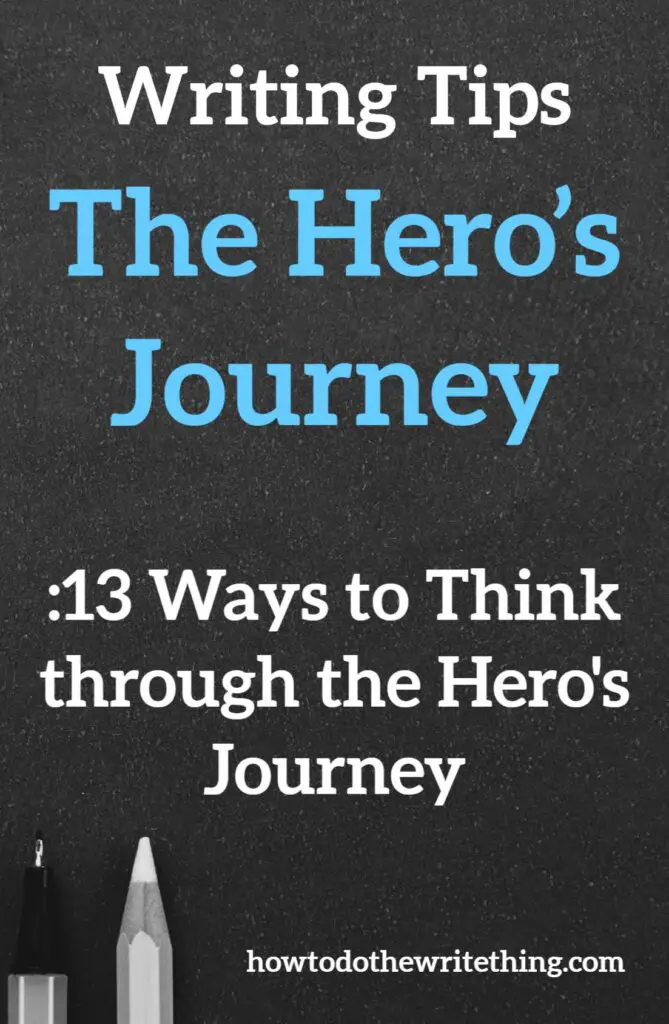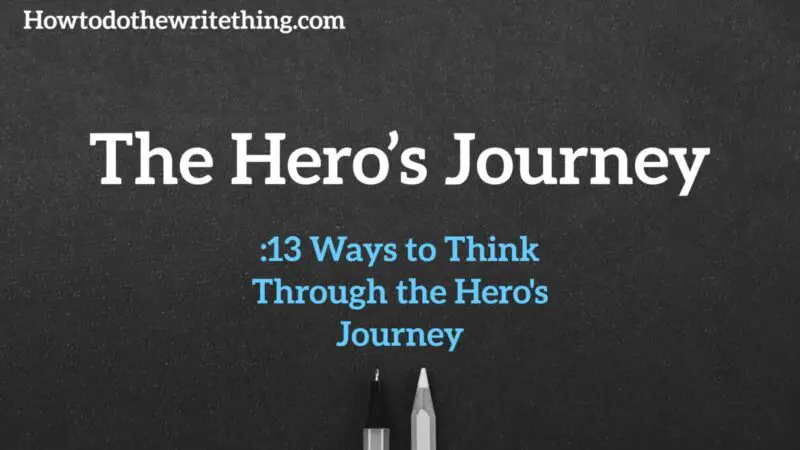
The Hero’s Journey
Have you read or seen enough about heroes to notice that there are repeating themes and patterns? Have you noticed certain arcs? Have you wondered what are the common steps that can be laid out to help you write your hero’s journey?
Well, Joseph Campbell did and he made a pretty famous analysis of the hero’s journey and this post will hopefully help you think through that and be able to summarize it for yourself.
My recommendation would not be to use these verbatim but to allow them to guide you, help you, and inspire your hero’s story. Your hero doesn’t have to have every step in their story.
The Common Steps of the Hero’s Journey:
“The Ordinary World”
You can take time to let your reader see the ordinary life of the hero. Allow them to see their family and friends. An ordinary day in the life of the soon to be hero.
Let your reader see into their ordinary world and this will make them be able to relate to them and start to like them.
This will help when you start to introduce conflicts to the hero’s journey. The reader will care more about how it ends then if they didn’t have this knowledge.
Allow your reader to see their character. Allow them to see flaws and certain mannerisms that only those that spend time with them would know. Allow your hero to be multi-dimensional.
Creating the ordinary life will create a meaningful and delightful contrast for the interesting turn of the story.
When you do start to introduce conflict it normally takes characters and readers out of “the ordinary world.”
“Central Dramatic Question”
Call it the major conflict or a major theme, the hero’s journey needs to have a major question.
The major question drives the hero further into the unknown. It drives the hero into more and more misadventure and it needs to be answered in the end.
“The Call to Adventure”
The step of the hero’s journey known as the call to adventure will interrupt the hero’s ordinary life. This is the problem or challenge that comes in front of the hero and must be resolved. If the call isn’t answered you have to make the stakes high enough to interest your reader. IF the hero fails, really bad things need to happen.
Sometimes a mentor type character can introduce the call to adventure.
Example would be the Hobbit. Gandalf shows up and recruits Bilbo to be the burglar for the dwarves.
This step in the hero’s journey can take many forms. So it is up to you what you want to be your main conflict to be. What genre you’re writing in and the setting in which you are writing can be a big determiner in what your call to adventure becomes.
“Refusal of the Call”
At first the hero can have conflicting feelings and want to refuse the adventure. In the Hobbit Bilbo at first just wants to keep his ordinary comfortable life.
It doesn’t always happen this way though, because some heroes’ challenges or conflicts are unrefusable.
If someone the hero loves is in life-threatening danger the hero may not have a choice. But some soon to be heroes have a choice whether or not they want to go on an adventure. Giving them the choice gives you the opportunity to reveal internal conflicts in your hero. Internal conflicts are interesting for character development.
The internal conflicts a character deals with allows the reader to get to know them in a more relatable sense.
Even if the hero doesn’t have any refusal of the adventure, the hero’s friends and family can show concern and reveal the dangers and risks involved in the hero’s journey.
If the journey isn’t perilous enough the reader won’t care to go along.
“Meeting the Mentor”
The hero can meet the mentor and the mentor can tell them about the adventure. The hero can meet the mentor along the journey, or the hero can meet the mentor and the mentor can drag them along on the journey.
In Disney’s the Sword and the Stone we see Merlin the mentor drag young King Arthur through his hero’s journey.
We watch Merlin take Arthur through each step seemingly whether he wants to or not.
Not all heroes have or need a mentor, but they can be helpful to more than just the hero. Mentors help make a multidimensional story for your reader to enjoy. It gives extra personalities for the reader to see and be engaged in.
Not every hero needs a mentor, but it is a very common feature in famous stories (Chronicles of Narnia, The Sword in the Stone, Lord of the Rings, Harry Potter, etc.)
The mentor is someone with experience. The hero will sometimes seek them out to find the experience they were lacking in order to be able to journey further or to take the journey at all.
“Crossing the Threshold”
Thus far your hero may have been introduced to the journey and rejected at first, but may have come back around to it. They may have even sought out help from a mentor to help them get the courage to take on the hero’s journey but with help.
If they have done all this they may be “Crossing the Threshold” which just means, they are now ready and fully committed to the hero’s journey and have accepted their calling and mission to venture into mysterious, perilous worlds unknown to them with guarantee of danger and no guarantee of return.
This means he is ready to leave the comforts of home and the life he once knew. To “cross the threshold” could literally signify there is no going back after this. She or he could be thinking “this is my last chance to say no to the hero’s journey. Bilbo was probably thinking, “I still have time to go back to the shire and start up my pipe.” But once our hero goes a certain way we as writers have to make the way shut behind them. This can happen several times in a story.
In the fellowship of the Ring, the fellowship wanders to the mines of Moria. They decide only a little too late to leave the mines and go another way when the monster in the lake collapses the way out. This can be seen as a crossing the threshold moment when our heroes stepped inside the mine they didn’t know there would be no turning back, but Tolkien did. He made sure of it.
You must find creative ways of doing this for your heroes. You have to find ways to give them no way to turn back decisions that bear weight of risk for the characters and thus the reader.
Are they jumping from a plane?
Are they stepping into an unknown portal?
Are they jumping into unknown waters?
Many thresholds are unknown to the heroes. When a crew of underwater divers takes an elevator down into the depths of an ocean complex, little did they know, but they would never take that elevator back up again. In a week that elevator would be sinking into the dark abyss.
There are many ways to create thresholds and your reader doesn’t have to know right away that your character is stepping through one, but you need to know and use it to create more risk and suspense for your reader to appreciate.
“Tests, Allies, and Enemies”
After the hero crosses the threshold into the new and unknown reality of the hero’s journey they have to get to know their new reality. Along the way they run into challenges, make new friends, and encounter the enemy or multiple enemies.
This is the time where you can continue to contrast the heroes old life to their new reality.
This new reality could be a new love or a new direction in life. This doesn’t just apply to demographics and other worlds. This new reality can be as simple as breaking up from a toxic relationship and our character moving on with the hopeful new adventure of true love.
Get creative and figure out ways to make the contrasts of their new reality clear and weighty.
Their new reality needs to be so different that tests are expected and allies are necessary. If the new environment isn’t risky then allies are needed. Make them needed. Don’t add allies just to have allies.
In their new reality enemies should be a part of their new reality. The reader should be waiting with anticipation for enemies to rear their ugly or beautiful heads (not every enemy is gross and dripping with green slime.) Some of the best ones are hidden in a shroud of beauty.
In many cases allies are earned not given, but this isn’t always true. Hercules was given Pegasus and Alladin was given Abu, but Katniss had to earn the respect of many of her allies through the hunger games. All of these allies are compelling and necessary, but they were acquired in different ways.
Allies and enemies can be tricky. In this allies can turn out to be truly enemies and enemies can turn out to be allies. Allies and enemies are good places to include twists and turns for the reader.
Some characters that start out as allies end up betraying the hero, and some characters that start as enemies end up helping the hero in the end. It is up to you to decide what fate the hero follows.
Challenges come in many forms.
Challenges can present themselves in the form of enemies and even the earning of allies. They can also be hard paths with much conflict for the hero. There may be many challenges for the hero on the hero’s journey. Challenges usually tie into the plot seamlessly and carry the reader along to the main challenge or the climax of the story.
“Approach the Inmost Cave”
The hero now makes their way to their toughest challenge yet. If they succeed, their ultimate goal is realized if they fail it is the ultimate failure. The ultimate failure might mean that this hero’s journey was always a tragedy. The ultimate success means a resolution for the hero and reader.
For the hero to truly approach the inmost cave they need to have completed their preparations. The battle plans must be laid out. Or the map must be looked at to see the exact place and time to entire the lair of the dragon.
The team has to be healed and ready for the ultimate battle.
Sometimes the hero and their team can come to the place of the inmost cave slightly unprepared and they can lose at first. Which means they weren’t really ready to face their most dangerous or most climactic challenge.
This can leave the audience confused and tricked, but in your story it could just be an unexpected twist.
The approach to the inmost cave is supposed to be the moment right before the hero’s greatest challenge and the end of their quest. They either end in victory or defeat, but whatever happens it is bringing the hero’s journey to an end. You can decide how they must prepare and if they are prepared enough to defeat their ultimate challenge and end their quest.
This ultimately leads them to their climatic moment.
“The Ordeal”
This is where the hero must face his most difficult challenge. She must see her foe for who they are and confront them head on. In the ordeal our hero must face their greatest fear and overcome it.
Their greatest fear could be many things.
They could face the evil dragon. They may face the serial killer they have been investigating. Their foe may be their evil father or step mother. Maybe their best friend stole their lover and must finally be confronted. This is the ordeal.
In this step the hero faces near or certain failure or destruction. If you have set up your story well, this is where the stakes will be the highest. Failure means the hero’s journey has failed and the ultimate bad ending has occurred.
In this climactic moment, the reader isn’t sure whether the hero will come out successful on the other side. It is the greatest and most threatening challenge they will face on our journey with them. They may need the help of an ally or they may have to endure the death of an ally before the final end.
The Hero’s Journey
Enjoying The Hero’s Journey? Take a moment and consider sharing this social-friendly image to say thanks and feel free to comment with your thoughts below! 🙂

The Hero’s Journey
And now a brief commercial break from The Hero’s Journey.
Need a Cheaper Plan? Try DreamHost.
If you enjoy The Hero’s Journey, storytelling, and writing in general, you might love owning a domain of your own where you can write about it? Ever want to own your own domain name (Yourname.com)?
Bluehost hosts your blog so that you can own your domain and make money blogging. Check them out only if you’re interested in making money blogging; otherwise, go for a free blog instead 🙂
Try Grammarly, The Free tool that should be in every writer’s toolbelt.
The Hero’s Journey
Check this out.
And now back to The Hero’s Journey!
“Reward”
The hero has met their greatest challenge and has conquered it. Now they receive their great reward.
They have achieved hero status or have gained the respect and love of their life.
The Reward is about conquering their greatest fears and coming out the other end to a victorious reward. That reward could be anything. It could be gold, silver, and precious jewels. It could be a status such as “King,” “Conqueror,” “CEO,” “President,” Etc.
The reward could be a love she or he has fought for and won or finally achieved. It could be as simple as becoming the most popular kid in school or as complicated as achieving King status.
It could be very little. The little boy finds his lost puppy. It could be very large. The commander wins the 10 year war.
Something to be noted. I do not think that the reward means the heroine has completed the journey unscathed or unchanged. To continue on normal life in light of the journey they have been on will be a task that should carry weight.
“The Road Back”
The hero must commit to finding their way back to the normalcy of life in the newly achieved world.
Bilbo goes back to the shire. Harry takes his kids to the train for their first ride to Hogwarts. These are small examples of the road back.
Some would argue that this step is a re-engagement with choosing to struggle through the climax and make it through to the resolution, but I would venture against that.
If done the way other authors illustrate this step the hero will readdress the main central question. They will be thrust into the final climax. They will be forced to defeat their greatest villain or conflict. The villain may have taken the reward or treasure and the heroine must confront them in a final moment where the stakes are the highest.
They either succeed and win or they fail and suffer the greatest consequence. Their loved ones could also suffer the greatest consequence.
If this is a tragedy then may fail.
“The Resurrection”
The resurrection can be that the hero has faced the utmost challenge and come out on the other side. She takes the skills she has learned on the heroine’s journey and uses them to defeat the villain.
She faces death first hand and survives. Her brush with death or the ultimate climax has caused her to change and be resurrected.
The resurrection can represent a cleansing for the hero or purification and transformation of life and character. This plays a major role in the hero’s character development. The Hero is transformed. He or she can be seen as a person that slightly maintains their old self but is resurrected into a new person that combines their old self with the new person they have become.
The resurrection represents that the hero has accepted their self-sacrifice in order to save the world. The world could refer to loved ones or the actual world, but in many stories, the hero is almost always asked to sacrifice self before they can truly be recognized as a hero.
Self-sacrifice is the only true way to show heroism. To sacrifice self when caring for others is the way the hero gains hero status.
Other allies can assist in this moment but sometimes it’s best to let the Hero stand alone. The Hero standing alone can make the stakes seem higher and the resolution be sweeter.
“Return with the Elixir”
The return with the elixir is the final moments of the hero’s journey.
The hero has completed the ultimate task and dealt with the major defining question. The hero has conquered their quest and is returning with the ultimate elixir that will solve the problems and deal with the major problem that the world has been facing.
The hero shares the elixir with the world. The elixir is the answer to the hero’s problems and everyone’s problems.
Sometimes the elixir is just for the hero and their family, but sometimes the elixir is for a nation or the entire world.
If the entire world is under an evil curse from a witch that makes it a frozen wasteland and the hero defeats the witch and summer finally comes, the elixir is the healing of the land.
Bilbo comes back with the ring and other valuables. Harry comes back with peace. The star-crossed lovers are reunited. It can even just be the experience of surviving the journey. It could be the rescue and return of a loved one. The elixir can heal physical, emotional, or spiritual wounds.
It represents a time of victory and rejoicing. Even if the hero comes to a tragic end the world is saved and the hero’s sacrifice is not in vain. It can be a victory celebration or a wedding celebration.
It can be a family being reunited after years of tragedy. The amount of people in the celebration is not the point as much as the richness of the celebration itself.
The elixir means that the journey is coming to a close and the world of the hero is again at peace. The elixir means that the world is back in balance and the hero and their kin can get back to living a peaceful life in their new normal world.
The hero is now free to live in their new life forever changed by the hero’s journey.
Hope this helps!
Happy writing!
Other Popular Posts you might enjoy:
5 Tricks How to Hide Your Villain Right Before Their Eyes
10 Tips How to Write Villains that Play Mind Games with Their Victims
4 Tips How to Write your Character Hitting Rock Bottom
10 Toxic Bad Habits That’ll Crush Your Fictional Character’s Relationships
How to Write From Your Villain’s Mind.
How To Write 4 Scenes That Reveal Who Your Character Is Seamlessly
Psychopath: How to Write The Perfect Psychopath
8 Tips How to Write the Perfect Sociopath
Fictional Characters: 28+ Bad Habits to Introduce to Your Fictional Characters
List of 10 Weapons for Fictional Characters
List of 10 Bad Habits Fictional Characters Need Help Breaking
The Hero’s Journey
Resources:
How to Start a Blog in 11 Simple Easy Steps in 2020
All the content for The Hero’s Journey is above but if you want to know more about blogging being your side hustle, read on.
Need a Cheaper Plan? Try DreamHost.
If you enjoy The Hero’s Journey, storytelling, and writing in general, you might love owning a domain of your own where you can write about it? Ever want to own your own domain name (Yourname.com)?
Bluehost hosts your blog so that you can own your domain and make money blogging. Check them out only if you’re interested in making money blogging; otherwise, go for a free blog instead 🙂
Try Grammarly, The Free tool that should be in every writer’s toolbelt.
The Hero’s Journey
Check this out.
We hope you enjoyed The Hero’s Journey!
The Hero’s Journey
Enjoying The Hero’s Journey? Take a moment and consider sharing this social-friendly image to say thanks and feel free to comment with your thoughts below! 🙂



The Hero’s Journey
Make sure your posts are readable. Use this readability score check
Want to check out a writer’s community to test your writing and get feedback?
The Hero’s Journey
The content for The Hero’s Journey is above this point, but if you want to make money blogging read on.
Need a Cheaper Plan? Try DreamHost.
If you enjoy The Hero’s Journey, storytelling, and writing in general, you might love owning a domain of your own where you can write about it? Ever want to own your own domain name (Yourname.com)?
Bluehost hosts your blog so that you can own your domain and make money blogging. Check them out only if you’re interested in making money blogging; otherwise, go for a free blog instead 🙂
Try Grammarly, The Free tool that should be in every writer’s toolbelt.
The Hero’s Journey
Check this out.
We hope you enjoyed The Hero’s Journey!
The Hero’s Journey
Check out these FREE trial resources from Amazon for when you work from home (or are stuck at home 🙂 )
Free Prime Membership Trial:
Try Amazon Prime 30-Day Free Trial
Try Prime Discounted (Free Trial)
Make your Free Amazon Wedding Registry:
Create an Amazon Wedding Registry
Get Free Video Channels Trial with Prime:
Join Prime Video Channels Free Trial
Try Free Amazon Family Trial:
Join Amazon Family (30-day Free Trial)
Get Unlimited Music for Free (30-day free trial):
Free movies and TV shows trial:
Join Amazon Prime – Watch Thousands of Movies & TV Shows Anytime – Start Free Trial Now
Free Prime for students trial:
Free Baby Registry:
Shop Amazon – Create an Amazon Baby Registry
Free trial of Twitch Prime:
The Hero’s Journey
And for when you REALLY work at home:
Create Amazon Business Account
It is the Amazon you love, for work. Make workplace procurement easier with convenient delivery options, simplified purchasing workflows, multiple payment options, and a competitive marketplace with business-only pricing and quantity discounts. Anyone who makes purchases for work (eg. procurement specialists, office administration, IT departments, etc.) can create a FREE account for their business. Customer must be from a verified business in order to successfully create their Amazon Business account.
We hope you enjoyed: The Hero’s Journey!




